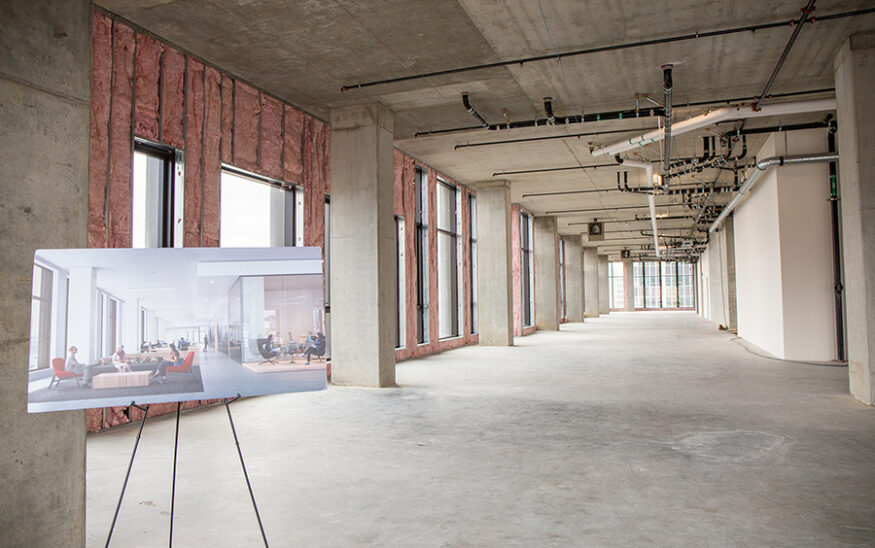Softness lingering in Portland’s urban office market
Chuck Slothower//April 10, 2024//
Downtown Portland’s office market continues to see a large stock of vacancies, while the area’s suburban market has become one of the busiest in the U.S.
The pandemic hangover is still affecting downtown, where hundreds of thousands of square feet have arrived since remote work became commonplace.
Still, analysts are seeing “green shoots” in the urban market, according to JLL. Activity is being driven by the expiration of short-term leases signed during the pandemic.
“I think we’re going to bounce here for probably two quarters, and then we’re going to start having improvement,” said Patricia Raicht, head of research for the U.S. West at JLL. “The tenants in the market that we’re tracking — two million-plus square feet of tenants in the market — there is basically a bubble of leases rolling because during the pandemic a bunch of people did short-term leases.”
U.S. office space averaged a 21.9 percent vacancy rate across major markets. Portland fared better than most, at 19.9 percent vacancy. Denver muddled through with a 24.1 percent total vacancy rate. Minneapolis-St. Paul was slightly worse than average with 22.3 percent vacancy.
Denver saw a steep rise in vacancy, with net absorption for the quarter at a 662,370-square-foot loss.
“With large occupiers, including Arrow Electronics, Starz and Wells Fargo, all shedding large blocks of space, absorption measured deeply negative — particularly in the Southeast suburban submarket and across the east side of the (central business district),” JLL stated.
In Portland, JLL’s data shows the urban office market had yet to hit bottom during the first quarter. Absorption fell by 460,000 square feet, and rents for class-A office slid by 6.4 percent to $37.49 per square foot.
Much of the weakness lies in less-desirable class-B and class-C office space that is typically in older buildings. Those categories accounted for 80 percent of office space returning to the market, JLL stated.
Kidder Mathews, in its quarterly report, stated current market conditions are likely to continue.
“The present office market favors tenants, with expectations of ongoing downward pressure on rates, rising concessions and tenant improvements, and extended periods of vacancy for leasing space anticipated throughout the year,” the brokerage’s research group said.
Lease signings are likely to pick up, Raicht said.
“There’s going to be a bunch of lease expiration activity,” she said. “Now that we’re somewhat settled into whatever this new normal is, folks are willing and able to make decisions about the future.”
Some of Portland’s largest buildings, such as the U.S. Bancorp Tower and the Wells Fargo Center are “struggling to maintain occupancy,” Raicht said. There have been positive signs, however, including Portland firm LegitScript signing a lease in the Unico Properties-owned U.S. Bancorp Tower, known as “Big Pink.”
New, class-A buildings including Block 216 and 11 West in downtown Portland still have vacancies. But there have been some move-ins. At 11 West, JGP Wealth Management moved in on Monday, occupying 6,200 square feet. Law firm Miller Nash LLP took 32,000 square feet at 11W earlier this spring.
“Things in the Portland office market, I think they’re getting better, not worse,” said Matthew Goodman, vice president of Downtown Development Group. “In our portfolio, we’re definitely seeing more activity than we saw a couple of years ago.”
It’s not just new buildings. Downtown Development Group’s downtown Kress Building has found new tenants including Carleton Hart Architecture and Cascade Energy Inc.
Some tenants are taking advantage of plentiful vacancies and reduced rents.
“It’s an opportunity for them to lock in a degree of value and upgrade their space, and we’re seeing that across our portfolio,” Goodman said.
Goodman attributed the uptick in downtown activity to a safer streetscape after the area’s issues with public homelessness and drug use grew to a crisis, and an improved retail environment.
“The office market depends on what’s happening at the ground level, from a streetscape and safety perspective, but also a dynamic and retail perspective, and I think that’s getting better on all fronts,” he said.
In another positive sign, some office users have been pulling advertised sublease space off the market. Daimler Truck North America recently withdrew 100,000 square feet of sublease space with the intention of reoccupying it, Raicht said.
Other companies have downsized and then reversed course. Deloitte, the consulting giant, vacated 20,000 square feet at Big Pink to take up 11,000 square feet at M Financial Plaza. The company later added another 13,000 square feet in the Brewery Blocks.
JLL’s data showed a stark divide between the Portland-metro area’s urban and suburban markets. Suburban office space in the area had only a 13 percent vacancy rate, second-best in the U.S., behind only San Diego.
Raicht attributed the divide in part to construction trends, as well as urban-to-suburban relocations.
“All of the construction that we had was in the urban core,” she said. “There’s basically been almost no construction in the suburbs. So, when market demand slowed, we had a lot of inventory (in the city).”
News
- Flint races to finish lead pipe work amid residents’ mistrust
- Building Blocks: Providence St. Vincent Medical Center remodel
- Projects totaling $17.3 million in top bidders | July 3, 2025
- Oregon housing production office opens
- Surfside condo collapse probe eyes construction flaws
- Oregon considering use of builder’s remedy to boost housing
- Tennessee racing venue becoming ballpark for game in August
- West Linn multifamily property fetches $33.6 million
- $26.9 million medical facility project in Portland building permits | June 30, 2025
- Multifamily property improvements in Portland land use review intakes | June 30, 2025
- Oregon lawmakers repeal wildfire hazard map
- Southern California delays gas appliance emission rules
Commentary
- From birth dates to pay disclosures: new rules for employers | Opinion
- It’s warming up out there: heed heat and smoke rules | Opinion
- Change is not the enemy, but it is an inevitable force | Opinion
- Construction labor shortages: a primer for owners and contractors | Opinion
- Lessons on legal lot verification from Lane County | Opinion
- May drama unfolds: The market climbs a wall of confusion | Opinion
- Beware of bias at bat: when AI benches the wrong players | Opinion
- Oregon bill offers a lifeline for journalism — and democracy | Opinion
- The telltale signs of meaningful camaraderie | Opinion
- Lease of mind: Why developers should consider lease options in real estate agreements | Opinion
- Leave administration 101: laws, documentation, obligations | Opinion
- Addressing wage theft issues in the construction industry | Opinion















